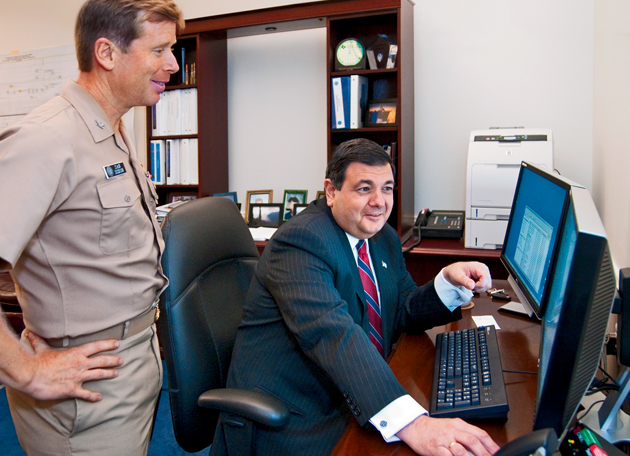
Zachary Lemnios was “at the right place at the right time,” he says, when he did his graduate work in the School of Engineering some 30 years ago. His exceptional early training allows him now, in today’s rapid pace of technology development, to help the U.S. military have the innovation, speed and agility to secure global access to knowledge.
But that’s just part of Lemnios’ charge as the U.S. Department of Defense’s chief technology officer, a position for which he received Senate confirmation in June 2009. In addition to overseeing the development and deployment of new technologies to aid soldiers in the field, his work delves into high-tech counter-terrorism, cyber-attack defense and sophisticated data mining to predict events that could compromise national security.
“I have responsibility for the entire science and technology budget [some $12 billion annually] for the department, to include the near-term advancements for our war fighters and the long-term investments that the department and the nation will need five, 10, 15 years from now,” says Lemnios, MSEE ’79. “That includes naval technologies, those on the ground and in the air, as well as space-based concepts to cyber concepts — the full gamut.”
Making the future now
Despite the futuristic face of Defense Research & Engineering that he directs, many of its technology developments aim at helping current combatants. That includes delivering 1,000 new mine-resistant vehicles monthly to U.S. forces in Iraq and Afghanistan, vehicles that embody “a fresh look” at armor and glass protection, says Lemnios.
Counter-terrorism technology also ranks high on his priority list. “We’re taking the very best ideas from the science and technology field and deploying them,” he says. Those ideas include persistent-surveillance techniques “to understand where the bad guys are and how they place IEDs, the improvised explosive devices.”
This requires processing massive data sets. “We now have the ability to put large sensors in small packages,” Lemnios says, “and provide rich feeds to data stations.”
Applied information processing, or informatics, is one area where Lemnios looks for significant new defense-technology breakthroughs. “We’re just now seeing ways to understand enormous data sets and use that to identify and maybe even predict future events. We can improve our weather prediction, as well as a country’s stability and other areas that are data rich — to see what the future will look like,” he says.
“We now have the ability to put in the palm of your hand, literally, 10, 15, 20 processor cores that a few years ago would be the entire processing capability of a major city. User interface is absolutely key,” Lemnios says.
Lemnios himself predicts that synthetic genomics — the creation of custom-designed genetic material — holds “enormous implications” in building synthetic tissue to help wounded warriors. “That work is actually very far along, both here and at DARPA [Defense Advanced Research Projects Agency] and at the Army medical laboratories,” he says. “To build synthetic tissue in a way that the body does not reject it is a significant accomplishment.”
Yet the greatest technology in the world is useless if not user-friendly. So Lemnios’ researchers work hard at making sure it is. “If it’s not intuitive, if it’s not embedded, if we don’t train with it, people don’t use it,” he says, pointing out that the most successful consumer technology products, such as iPhones and other handhelds, are the ones that can be operated most intuitively. “We have very strong research threads in the department for user interfaces. How do we build displays and information portals that interact with the user in a useful way? We now have the ability to put in the palm of your hand, literally, 10, 15, 20 processor cores that a few years ago would be the entire processing capability of a major city. User interface is absolutely key.”
Good mentors, good luck
Lemnios claims that his rise to the pinnacle of U.S. defense technology research would not have been possible without some good mentoring and some good luck.
His father, a retired Massachusetts Institute of Technology Lincoln Laboratory electrical engineer, was a major influence. “I was sort of told that I was going to be an electrical engineer, and I never quite looked back,” Lemnios says. “Then a seventh-grade science teacher got me excited about science. And I had a strong mentor at the University of Michigan who pointed me to Washington University for my graduate work.”
At the Washington University School of Engineering’s Sever Institute, Lemnios worked in the late Fred Rosenbaum’s microwave laboratory, which adjoined the materials lab of Charles Wolfe, the former Samuel C. Sachs Professor who died in 2008. “I had a joint research thesis [“The Fabrication and Evaluation of Microwave Field Effect Transistors”] between those two laboratories. I really enjoyed it, doing a lot of research that hadn’t been published before in a field that was emerging,” he says. “It turned out that the Department of Defense sponsored much of that work. That was my first interaction with government-funded research.
“I was challenged in academics in grad school — enormously, but it was absolutely rewarding. I think the environment had a lot to do with it; I had superb folks around me.”
Upon graduating, Lemnios went to work at the Hughes Aircraft Company’s Torrance Research Center, where he conducted microwave research, among other things. In 1980, he moved to Westinghouse Electric Corporation’s Advanced Technology Division as a senior engineer, directing the development of advanced process techniques for microelectronic components, and in 1983, he began a seven-year stint as special programs manager at Ford Microelectronics, Inc., managing multiple project teams developing advanced microelectronic components.
Moving to DARPA in 1991, Lemnios became program manager and assistant director in the Electronics Technology Office at the Department of Defense’s main research and development agency. There he helped pioneer work in microelectronics, radar, high-speed circuits and semiconductors. That led, in 1997, to a senior staff position at MIT’s Lincoln Laboratory, a federally funded research and development center chartered to apply advanced technology to problems of national security. At Lincoln, he worked in advanced microelectronics applications and novel solid-state system concepts.
By 2002, he had moved back to DARPA as the Information Processing Technology Office’s deputy director and subsequently to the directorship of its Microsystems Technology Office. He returned to the Lincoln Laboratory’s Solid State Division three years later. Then, in 2006, he was named Lincoln’s chief technology officer.
Yet for all his success in the science and technology field, he worries that today’s students are being turned off by math and science.
“This country is highly ranked in fourth-grade math and science. But by the time our students get to ninth and 10th grade, we’re in the mid- to lower-tier,” Lemnios says. “So something happens where kids are discouraged or are not inspired.”
In an increasingly high-tech world — where effective U.S. defense efforts will likely rely in large part on high-tech counters to threats — that educational gap is troubling, Lemnios says.
“We all have a responsibility to inspire young people to move into science and technology, engineering and math as a profession,” he says.
Rick Skwiot is a freelance writer based in Key West, Fla.

Comments and respectful dialogue are encouraged, but content will be moderated. Please, no personal attacks, obscenity or profanity, selling of commercial products, or endorsements of political candidates or positions. We reserve the right to remove any inappropriate comments. We also cannot address individual medical concerns or provide medical advice in this forum.